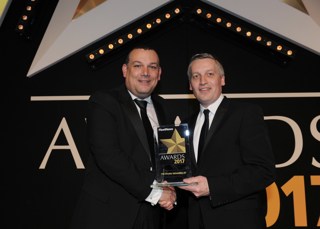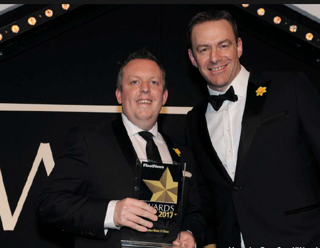That’s the claim award winner Justin Wand (below centre) made when he joined LAS, the ‘jewel in the crown’ of the ambulance service.
Less than three months after collecting the Fleet News fleet manager of the year award, among several trophies that night for his South East Coast Ambulance Service (SECAmb) fleet, Justin Wand received a call from an agency representing London Ambulance Service (LAS).
Word had travelled fast; LAS had a vacancy for a deputy director, fleet and logistics – was he interested?
“There’s no doubt my profile had been raised by the Fleet News Awards; it was great recognition within the ambulance service,” Wand says.
He took the job, and after just five weeks was able to identify significant opportunities for his new organisation with a clearly defined view about the immediate future for the fleet operation. When questioned by superiors for his feedback, in addition to an outline summary, he told them, “let me invest £10 million and I’ll save you £28m of clinical time that can be reinvested back into frontline services”.
It was a compelling argument; £7m has already been made available for investment in new vehicles, new processes and a new structure.
Fleet News: What did you think when you joined LAS?
Justin Wand: LAS is the jewel in the crown for the ambulance service – it’s the busiest one in the world and everyone wants it on their CV. It was a big step to move here; it has the profile but it hasn’t been through a lot of the changes we’ve seen elsewhere, leaving a great opportunity to improve the fleet operation.
FN: What are your initial plans?
JW: I have a clear mandate to modernise the fleet and logistics support functions. We will introduce a version of the ‘make ready’ process we had at SECAmb and that will help return a massive proportion of the planned efficiency savings, a fair segment of which will be in the first year. We will establish 14 vehicle preparation ‘hubs’ across our patch that will support day-to-day frontline operations, logistics and maintenance of the vehicles and the equipment – a one-stop shop. We will also change our production functions, which will benefit staff and patients, by having the right equipment in the right place, produced and maintained to standard in a safe, clean, infection-controlled, compliant environment.
FN: You are also investing in new vehicles; what changes are you planning here?
JW: The fleet has grown organically in recent years, so we have to standardise this as much as possible to remove variation. We operate around 20 different platforms; I want to get this down to two or three key ones that will reflect the specialist nature of the staff roles but minimising the range for the maintenance team. It’s about redesigning the system to be sustainable, efficient and replicable to remove variation – variation is the enemy of quality.
FN: You operate long replacement cycles: how cost-efficient is this?
JW: Currently we have a seven-year operating cycle for ambulances across the service and five years for rapid response cars. Predominantly this has been dictated by public sector funding of fleet replacements of this type. But, by understanding wholelife costs, we start to see a dramatic increase in running costs around year five, so we have to look at the opportunities. We need a fleet that reflects the spend profile throughout the whole life of the asset as well as the right vehicle for the right role. We may see some modular-build ambulances, which are bigger and more fuel hungry, replaced by van conversions as we reconfigure the fleet. Do we buy cheaper vehicles more often and ultimately spend our money in a different way? Or do we look at a mid-life refresh of the chassis and remount the boxes on a new vehicle? We’ve got into a habit of doing what’s easiest, not necessarily the most efficient, but that’s all part of the challenge.
FN: Is there an opportunity for greater collaboration within the ambulance service, similar to the police fleets?
JW: Undoubtedly; we have national frameworks for buying vehicles and equipment which gives us great economies of scale. But we have to recognise that there are configuration differences – geographically, equipment, skills-set, treatment regimes and in back office support, too – all of which may influence different layouts in our vehicles. There is also a push to work more with other services and there are real opportunities with police and fire services for potentially sharing support functions, workshops and processes. First though we have to understand where the real alignments are – vehicle maintenance, stations, call centres or back office support? It’s all about strategic planning.
FN: When you have drivers rushing to get to a call, with time-led targets, how do you instil a safe driving culture?
JW: We have to do our jobs more smartly; there is more congestion and patients’ expectations are increasingly changing. We can improve systems within the vehicle, introducing car safety technology on commercials, and we are working with Transport for London (TfL) to identify priority routes at certain times of the day. But we also have to re-educate drivers and managers to make more informed decisions when responding. Staff also have to recognise that a crucial part of the patient experience is how they are transported. Making the link to clinical outcomes is the real key to success. Mark Crouch, an ex-Met police officer, has also recently joined LAS and we will be working closely to increase our driver profiling, performance and education.
FN: What’s the key to being a successful fleet manager?
JW: You have to understand the business intimately and apply a lot of the corporate language to the operation, reflecting it back to the wider organisation so they understand the efficiencies and effectiveness a good fleet management team can provide. I use the language from the frontline operations in our teams and it is reflected in our key performance indicators and our wider business planning
FN: You still work as a paramedic – how does that help?
JW: It reminds me why we are all here and it also gives me credibility with the staff. Previously this approach has allowed me to change the culture of the technical support teams so they understand the crucial role they play in saving lives every day. They are often hidden away and often under-valued. At SECAmb we put the fleet function front and centre in terms of the criticality of the services they provide the frontline and I don’t see why that should be any different here. It changes the way we’ll engage the wider organisation and it changes the view of the senior management team around fleet considerations.
Wand’s role as a paramedic also gives him first-hand experience of customers’ needs and changing requirements. He believes LAS’s role is changing from an emergency response service to a mobile healthcare provider, fulfilling a need in the community for more holistic care provision.
“That transition provides us with an opportunity to consider the future design of services and what that means for vehicles and equipment,” he says. “It is our role to provide the best vehicle and equipment support we can to enable the frontline staff to fulfil their crucial roles and focus on their goal – committed, clinically excellent patient care.”



















Login to comment
Comments
No comments have been made yet.